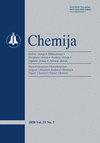QSARs in prooxidant mammalian cell cytotoxicity of nitroaromatic compounds: the roles of compound lipophilicity and cytochrome P-450- and DT-diaphorase-catalyzed reactions
IF 0.4
4区 化学
Q4 CHEMISTRY, MULTIDISCIPLINARY
引用次数: 3
Abstract
4 Institute of Bioorganic Chemistry, NAS of Belarus, Kuprevicha 5/2, BY-220072 Minsk, Belarus Frequently, the aerobic mammalian cell cytotoxicity of nitroaromatic compounds (ArNO2) increases with their single-electron reduction potential (E7), thus reflecting the relationship between their enzymatic single-electron reduction rate and E7. This shows that the main factor of ArNO2 cytotoxicity is redox cycling and oxidative stress. In this work, we found that the reactivity of a series of nitrobenzenes, nitrofurans and nitrothiophenes towards single-electron transferring NADPH:cytochrome P-450 reductase and adrenodoxin reductase/adrenodoxin increases with their E7. However, their cytotoxicity in mouse hepatoma MH22a and human colon carcinoma HCT-116 cells exhibited a poorly expressed dependence on E7. The correlations were significantly improved after the introduction of compound octanol/water distribution coefficient at pH 7.0 (log D) as a second variable. This shows that the lipophilicity of ArNO2 enhances their cytotoxicity. The inhibitors of cytochromes P-450, α-naphthoflavone, isoniazid and miconazole, and an inhibitor of DT-diaphorase, dicoumarol, in most cases decreased the cytotoxicity of several randomly chosen compounds. This shows that the observed cytotoxicity vs E7 relationships in fact reflect the superposition of several cytotoxicity mechanisms.qsar在硝基芳香族化合物的促氧化性哺乳动物细胞毒性中的作用:化合物亲脂性和细胞色素P-450-和dt -diaphorase催化反应的作用
4白俄罗斯NAS生物有机化学研究所,Kuprevicha 5/2,BY-220072明斯克,白俄罗斯经常发现,硝基芳族化合物(ArNO2)的需氧哺乳动物细胞毒性随着其单电子还原电位(E7)的增加而增加,从而反映了其酶促单电子还原速率与E7之间的关系。这表明ArNO2细胞毒性的主要因素是氧化还原循环和氧化应激。在这项工作中,我们发现一系列硝基苯、硝基呋喃和硝基噻吩对单电子转移NADPH:细胞色素P-450还原酶和肾上腺素还原酶/肾上腺素的反应性随着它们的E7而增加。然而,它们在小鼠肝癌MH22a和人结肠癌HCT-116细胞中的细胞毒性表现出对E7的低表达依赖性。在引入pH 7.0下的化合物辛醇/水分配系数(log D)作为第二个变量后,相关性显著改善。这表明ArNO2的亲脂性增强了它们的细胞毒性。在大多数情况下,细胞色素P-450、α-萘黄酮、异烟肼和咪康唑的抑制剂,以及DT黄递酶的抑制剂双香豆素降低了几种随机选择的化合物的细胞毒性。这表明观察到的细胞毒性与E7的关系实际上反映了几种细胞毒性机制的叠加。
本文章由计算机程序翻译,如有差异,请以英文原文为准。
求助全文
约1分钟内获得全文
求助全文
来源期刊

Chemija
化学-化学综合
CiteScore
1.30
自引率
16.70%
发文量
14
审稿时长
>12 weeks
期刊介绍:
Chemija publishes original research articles and reviews from all branches of modern chemistry, including physical, inorganic, analytical, organic, polymer chemistry, electrochemistry, and multidisciplinary approaches.
 求助内容:
求助内容: 应助结果提醒方式:
应助结果提醒方式:


